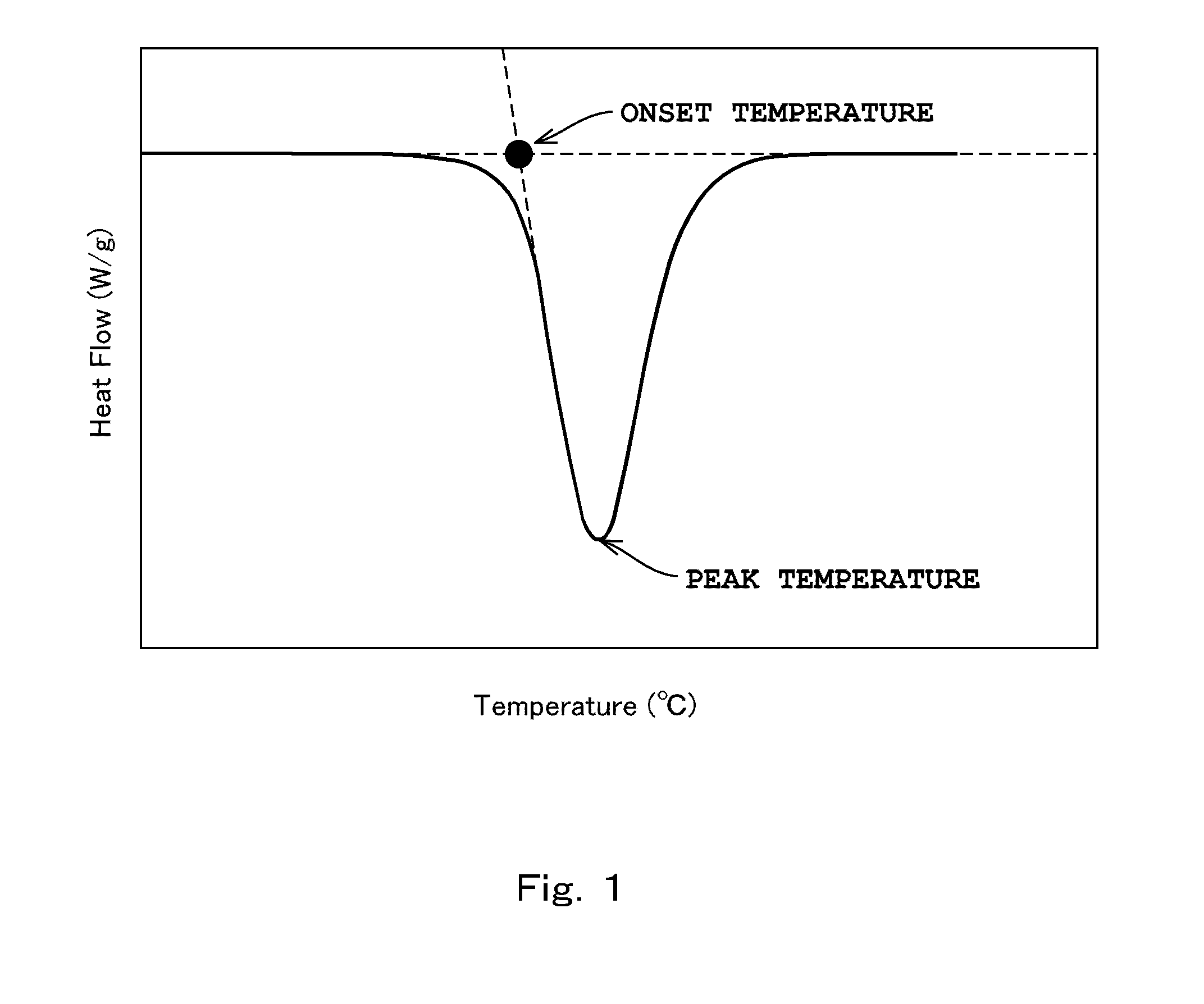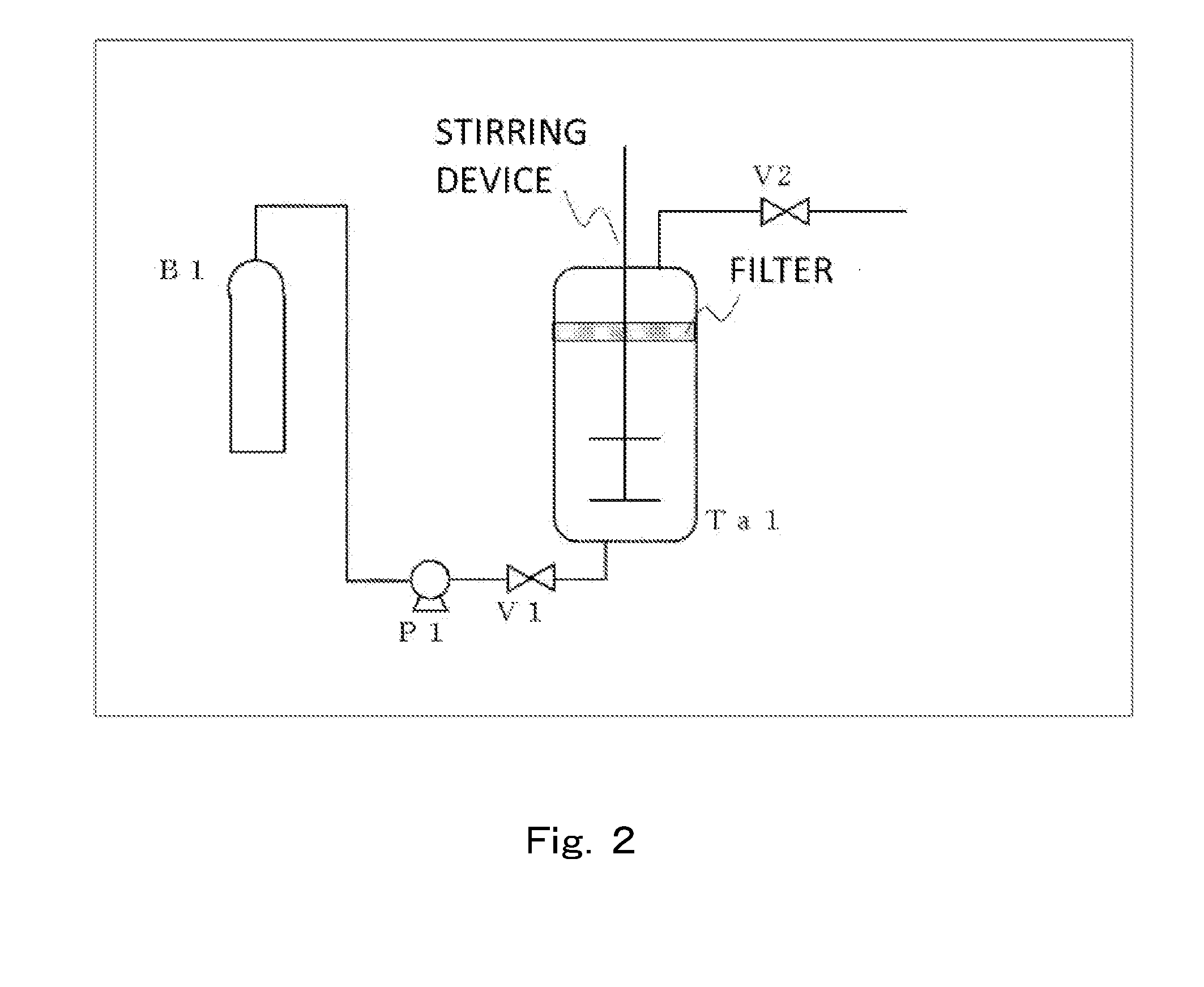Toner production method
a production method and technology of toner, applied in the field of toner production methods, can solve the problems of increased susceptibility to crystallinity loss, inability to form a completely ordered structure, and difficulty in simultaneously realizing the low-temperature fixability and heat-resistant storage of toners, and achieves superior low-temperature fixability and heat-resistant storage. , the effect of easy to obtain
- Summary
- Abstract
- Description
- Claims
- Application Information
AI Technical Summary
Benefits of technology
Problems solved by technology
Method used
Image
Examples
example 1
[0364]Pressurized annealing was subsequently carried out in Untreated Toner Particle Production Method 1 with the untreated toner particles and carbon dioxide remaining in the granulation tank Ta2 of the device shown in FIG. 3.
[0365]The internal temperature of the granulation tank Ta2 was adjusted to a temperature of 35° C., and the valve V3 was opened to introduce carbon dioxide (purity: 99.99%) into the granulation tank Ta2 from the tank B2 using the pump P2 while stirring at 150 rpm, followed by raising the pressure to 10.0 MPa. When the pressure reached 10 MPa, the pump P2 was stopped and the valve V3 was closed followed by holding at that pressure for 30 minutes. After 30 minutes had elapsed, the pressure regulating valve V5 was opened and carbon dioxide was discharged outside the granulation tank Ta2 followed by reducing the pressure of the tank Ta2 to atmospheric pressure. After discontinuing stirring, the granulation tank Ta2 was opened to obtain “Treated Toner Particles 1” ...
examples 2 to 23
[0367]Toners 2 to 23 subjected to pressurized annealing treatment were obtained in the same manner as Example 1 with the exception of changing the untreated toner particles, retention pressure, retention temperature and retention time in Example 1 to the conditions shown in Table 6.
[0368]However, in the case the pressure of the granulation tank Ta2 prior to pressurized annealing treatment was higher than the retention pressure of pressurized annealing treatment, the pressure regulating valve V5 was opened and retention pressure was adjusted to the prescribed retention pressure by discharging carbon dioxide outside the granulation tank Ta2.
example 24
[0369]The valves V1 and V2 in the device shown in FIG. 2 were closed, the Toner Particles 10 were placed in the Tank Ta1 adjusted to an internal temperature of 35° C., and the tank Ta1 was sealed. The valve V1 was opened to introduce carbon dioxide (purity: 99.99%) into the tank Ta1 from the tank B1 using the pump P1 while stirring at 150 rpm, followed by raising the pressure to 10.0 MPa. When the pressure reached 10 MPa, the pump P1 was stopped and the valve V1 was closed followed by holding at that pressure for 30 minutes. After 30 minutes had elapsed, the valve V2 was opened and carbon dioxide was discharged outside the tank Ta1 followed by reducing the pressure of the tank Ta1 to atmospheric pressure. After discontinuing stirring, the tank Ta1 was opened to obtain “Treated Toner Particles 10” that had undergone pressurized annealing treatment.
[0370]1.8 mass parts of hydrophobic silica fine powder treated with hexamethyldisilazane (number-average primary particle diameter: 7 nm) ...
PUM
| Property | Measurement | Unit |
|---|---|---|
| pressure | aaaaa | aaaaa |
| temperature | aaaaa | aaaaa |
| temperature | aaaaa | aaaaa |
Abstract
Description
Claims
Application Information
 Login to View More
Login to View More - R&D
- Intellectual Property
- Life Sciences
- Materials
- Tech Scout
- Unparalleled Data Quality
- Higher Quality Content
- 60% Fewer Hallucinations
Browse by: Latest US Patents, China's latest patents, Technical Efficacy Thesaurus, Application Domain, Technology Topic, Popular Technical Reports.
© 2025 PatSnap. All rights reserved.Legal|Privacy policy|Modern Slavery Act Transparency Statement|Sitemap|About US| Contact US: help@patsnap.com



